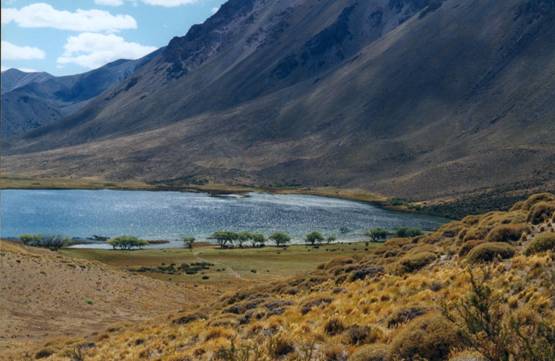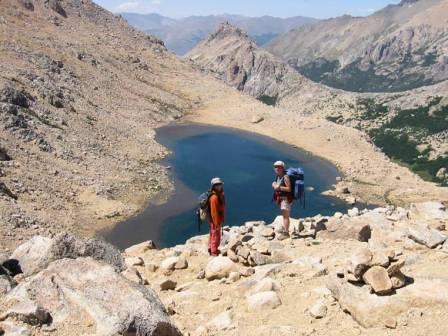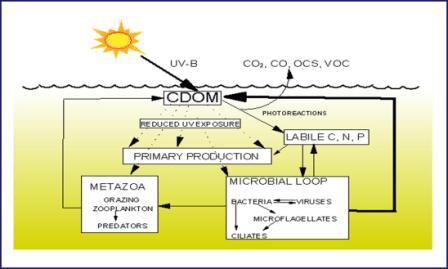Overview of My Research Interests
I have a broad interest in aquatic ecosystem ecology but the consistent underlying theme of my research has been investigations into the role of dissolved organic carbon (DOC) in freshwater ecosystems. Dissolved organic carbon is widely recognized to be a major structuring agent of aquatic ecosystems, having a profound influence on the transparency, heat budget, water column stability, pH, and metabolism of lakes. My work has encompassed 3 broad areas related to DOC and lakes: 1) aquatic ecosystem productivity, 2) aquatic ecosystem optics, and 3) photolytic transformation of DOC. Much of my scholarly work is collaborative in nature, being conducted with multidisciplinary teams of scientists. My role in these collaborative projects typically relies on my expertise in the area of DOC composition and dynamics or my expertise in the role of DOC in structuring optical properties of aquatic ecosystems. An additional role for me in many of these collaborative projects is in the quantifying and characterizing (either chemically or optically) DOC, for which my laboratory is uniquely suited.
Aquatic Ecosystem Productivity
Early work in my career centered on the environmental regulation of carbon fixation via algal photosynthesis and carbon mineralization via hertertrophic bacterial respiration. This research helped to establish the role of inorganic nutrient limitation in the regulation of both carbon fixation and microbial carbon mineralization. The work on bacterial production in Lake Dillon, Colorado remains as one of the most comprehensive studies on the seasonal variability and environmental control of bacterial production in lakes. My research on photolytic transformations of DOC overlaps this major research thrust. This is largely because photooxidation increases the biological lability of DOC and can stimulate heterotrophic bacterial production in aquatic ecosystems. A new research area that I am exploring with my graduate students is related to bacterial respiration and growth efficiency in streams and rivers in relation to the source, composition, and concentration of DOC. I anticipate that in-channel DOC photolysis will also play a major role in this line of research.

Optics of Aquatic Ecosystems
Chromophoric (colored) DOC plays an important role in regulating the light environment of lakes, especially with respect to the penetration of potentially damaging UV radiation. My expertise in the area of DOC has positioned me to play a central role in documenting and modeling UV transparency in lakes and streams. Our study of a large number of lakes from different ecogeographic regions of the western hemisphere documented the natural variability of UV transparency and determined that it was primarily regulated by the quality and concentration of DOC. This study was one of the first to document the UV-DOC relationship in lakes and the resulting model is still widely utilized by limnologists. Since the UV optical environment of lakes and oceans was much better characterized than those of streams, I refocused my attention on lotic environments. Our recent EPA grant endeavored to characterize the UV optical environment of streams in relationship to watershed landscape and land use characteristics. Several manuscripts by my recent Ph.D. student ( Belmont) can be expected to make a major impact in this area. My expertise in this field was recently recognized when I was invited to write a chapter titled “Optical Properties of Water” which is being published in the Encyclopedia of Inland Waters.


Photolytic Transformation of DOC
Because chromophoric DOC strongly absorbs solar UV radiation, it is subjected to photolysis. DOC photolysis has two major consequences for aquatic ecosystems. First, photolysis ‘bleaches” the chromophoric DOC and thus causes the water column to become more transparent to UV radiation. My early work in photolysis involved the measurement of natural photobleaching rates of DOC in several lakes on the Pocono Plateau. From these rate constants, I then developed a model which used incident solar radiation to predict whole-lake changes in transparency. Confirmation of this model provided the first evidence in the literature that the transparency of entire lake ecosystems could be affected by solar photobleaching. I continued this research thrust by measuring DOC photobleaching rates in a large number of ecosystems across the western hemisphere. This work documented the natural range of variability in photobleaching rate constants and provided insight into how this may be regulated on an ecosystem basis. Related work with one of my graduate students (Osburn) produced spectral weighting functions for photobleaching of DOC from lakes in the Poconos as well as Argentina andChile. Osburn and I also documented that photolysis of chromophoric DOC can cause chemical as well as optical changes in lakes. Photolysis not only changes the chemical structure of DOC but can also affect the isotopic composition. This finding has important implications for investigators using stable isotopes of carbon to study aquatic food webs. My graduate students and I have also investigated the seasonal and spatial level variability of photobleaching in the Lehigh River watershed. Obviously my research of DOC photobleaching closely overlaps that of aquatic ecosystem optics discussed above.


The second major consequence of DOC photolysis is that it breaks molecular bonds and increases the biological availability (lability) of the carbon. This alters the carbon dynamics in aquatic ecosystems and may stimulate the production of heterotrophic bacteria. My early work on lake ecosystems demonstrated a complex interaction between the stimulation of bacterial production due to DOC photolysis and the direct inhibition of bacterial production due to direct UV inhibition (Ph.D dissertation of Kresge). More recent research using plug-flow bioreactors and static chambers has documented the importance of DOC photolysis to carbon dynamics in a variety of lake and stream ecosystems.

For the past several years I have been involved in a multi-collaborator mesocosm study (twelve 0.75 x 8 m plastic tubes suspended in a lake) in which DOC concentration and solar UV radiation was manipulated. The goal of this study (in part) was to determine the role of UV-DOC photolysis in structuring microbial food webs. My primary role in this project was in developing and implementing a method of producing large volumes (8,000 L) of highly concentrated, natural DOC for use in the study. I was also responsible for characterizing optical and chemical changes in the mesocosms during the course of the study. The first manuscript from this project is now in press and deals with the role of solar UV radiation and DOC concentration in regulating mercury emissions from lake ecosystems. Other manuscripts are currently in preparation.
